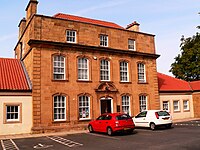Normanby, North Riding
| Normanby | |
| Yorkshire | |
|---|---|
 Normanby High Street | |
| Location | |
| Grid reference: | NZ555185 |
| Location: | 54°33’25"N, 1°9’25"W |
| Data | |
| Population: | 6,930 (2011) |
| Post town: | Middlesbrough |
| Postcode: | TS6 |
| Dialling code: | 01642 |
| Local Government | |
| Council: | Redcar and Cleveland |
| Parliamentary constituency: |
Redcar |
Normanby is a village in the very north of the North Riding of Yorkshire which has been swallowed up into a part of the urban area of Eston, itself barely separated from [Middlesbrough]] to the north-west.
This was once a township of the parish of Ormesby.
History

In 1870–72, John Marius Wilson's Imperial Gazetteer of England and Wales described Normanby like this:
NORMANBY, a village and a township in Ormsby parish, N. R. Yorkshire. The village stands 2.0 miles (3.2 km) N E of Ormsby r. station, and 4 W N W of Guisborough; and has a post-office under Middlesbrough. The township extends to the coast; and comprises 1, 343 acres of land, and 355 of water. Real property, £7, 949; of which £4,060 are in iron-works. Pop. in 1851, 195; in 1861, 2, 204. Houses, 397. The increase of pop. arose mainly from the opening of extensive ironstone works, and from the establishing of glass furnaces. Norman by Hall is a chief residence. Bricks and tiles are made. There is a national school.—John Marius Wilson, Imperial Gazetteer of England and Wales[1]
Flatts Lane Woodland Country Park

Flatts Lane Woodland Country Park is an area of woodland in Normanby, sheltered from the urban sprawl below in the Tees Valley. It provides residents with a place to walk and exercise, and aims to give a 'countryside experience' without a long journey to reach it.
There is a visitors' centre – which stands on the site of the former Normanby Brickworks. Some of the walkways in the park follow the course of the now defunct Cleveland Railway, which served the brickworks. The visitors' centre has exhibits and information about wildlife and conservation, as well as serving as a base for the information-giving Ranger.
The park boasts a variety of habitats, including both deciduous and coniferous woodlands, grassland and ponds. There are plenty of walks throughout the wooded areas of the park, an outdoor exercise area and a children's playground. There is a network of bridleways which cyclists and horseriders are welcome to use.
In the past, Flatts Lane was a road used by monks, farmers and traders to carry goods between markets and coastal ports. The cobbled path can still be seen in some places as it runs across the site. Godfalter Hill is a prominent landmark topped by its distinctive beech trees making it visible for miles around.
Flatts Lane Woodland Country Park, in Normanby, is an easy starting point for walks to Eston Nab; the path leading to the high ground of Eston Moor forms a less severe incline than more popular routes from Eston. It is also on the long-distance path called the Tees Link; the path travels along the route of a former railway which served Normanby Brickworks.
Landmarks


Normanby Hall[2] is a mansion on the western side of Normanby. The manor of Normanby was held at an early period by the de Brus family, of Skelton Castle; and subsequently passed to Marmaduke de Thweng. Later it came into the possession of the Percys, and then, of the Moneys.
At the beginning of the eighteenth century, the estate belonged to William Pennyman, Esq. When he died, in 1718, buried at Eston Church, his daughters Elizabeth and Joanna, married two brothers – Rev. William Consett and Captain Matthew Consett, sons of William Consett of Linthorpe.
The manor lands were split, Reverend William Consett taking the eastern part of the estate, upon which he built the elegant and commodious Normanby House, which became known as the Manor House.[3] The other brother, Captain Matthew Consett, took the part of the manor with the ancient Hall.[4]
The Hall with a moiety of the estate was purchased in 1748, by Ralph Jackson, on the death of Captain Consett. The common fields around it were enclosed, in 1790, to become parkland for the mansion. It descended through the Jackson family, in the late 1880s, to Major Charles Ward-Jackson M.P., who was lord of the manor, and who died in 1930.[5]
In the twentieth century, it came into the hands of Charles Amer, a former jazzband leader (of the Charles Amer Orchestra, and hotel-owner. Amer later sold the parkland belonging to the Hall and houses were built. The Hall itself, after several years as a retirement home, is now unoccupied and in a state of disrepair.
Sport
- Cricket: Normanby Hall Cricket Club
Outside links
| ("Wikimedia Commons" has material about Normanby, North Riding) |
See also
References
- ↑ "History of Normanby, in Redcar and Cleveland and North Riding". University of Portsmouth. https://www.visionofbritain.org.uk/place/13834.
- ↑ [1]
- ↑ "The Manor House Surgery, Normanby". Themanorhousesurgery.co.uk. 31 December 2012. http://www.themanorhousesurgery.co.uk/.
- ↑ Ord, John Walker (1846). "The history and antiquities of Cleveland: comprising the wapentake of East & West Langbargh ... By John Walker Ord". https://books.google.com/books?id=qPsnAAAAYAAJ&q=normanby+house&pg=PA564.
- ↑ "Description from Bulmer's History and Directory of North Yorkshire (1890)". Genuki.org.uk. 22 January 2012. http://www.genuki.org.uk/big/eng/YKS/NRY/Eston/Eston90.html.
